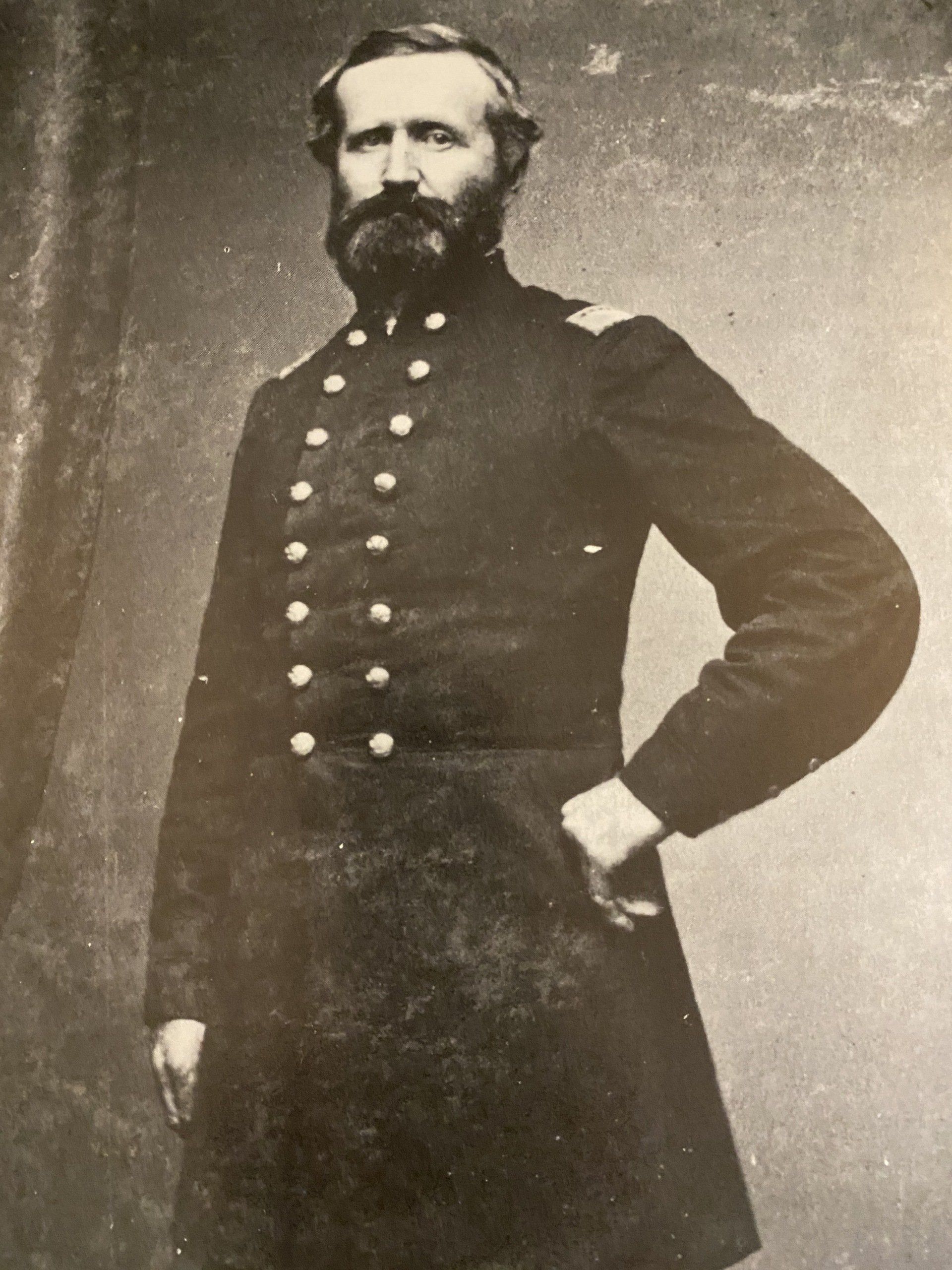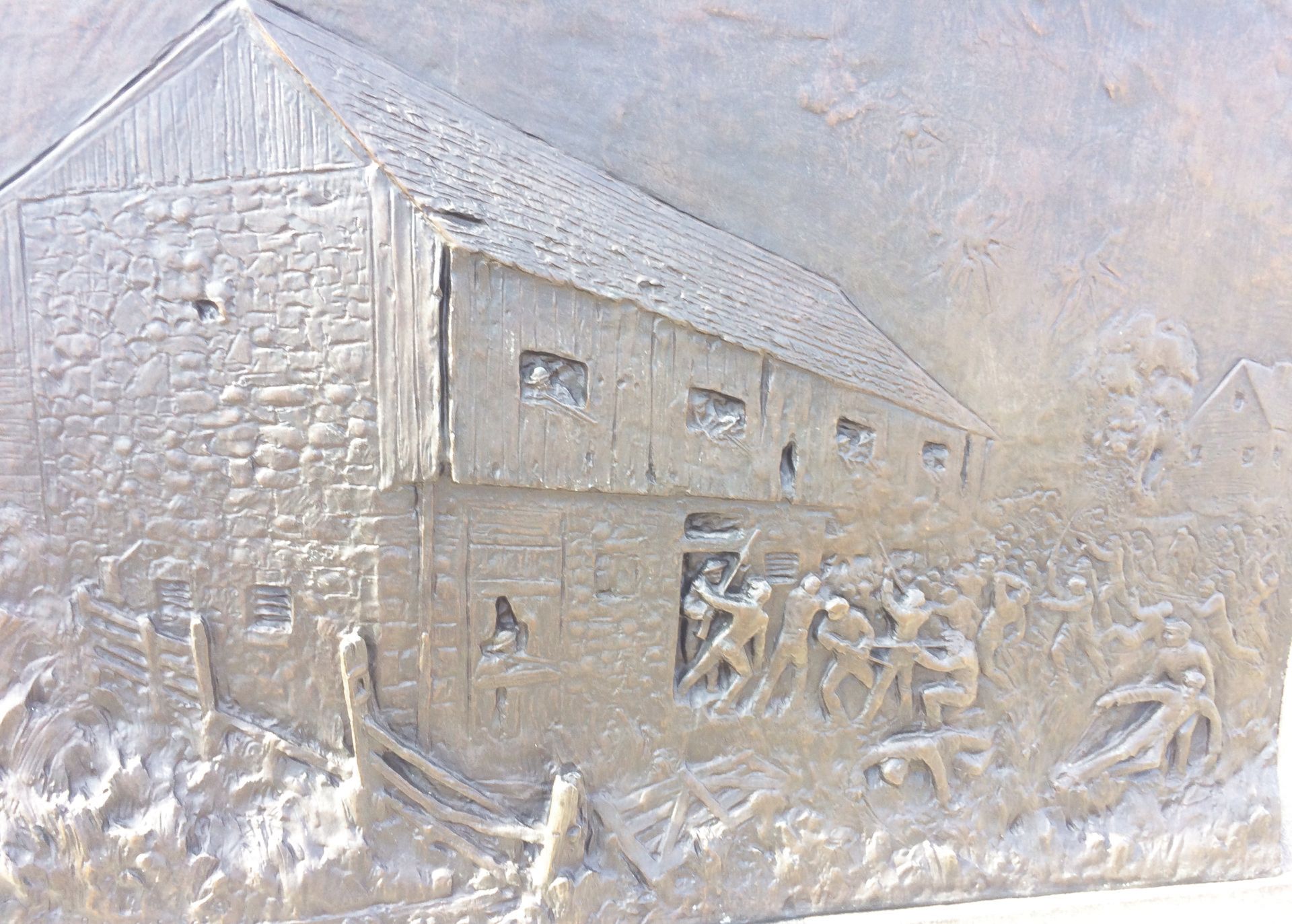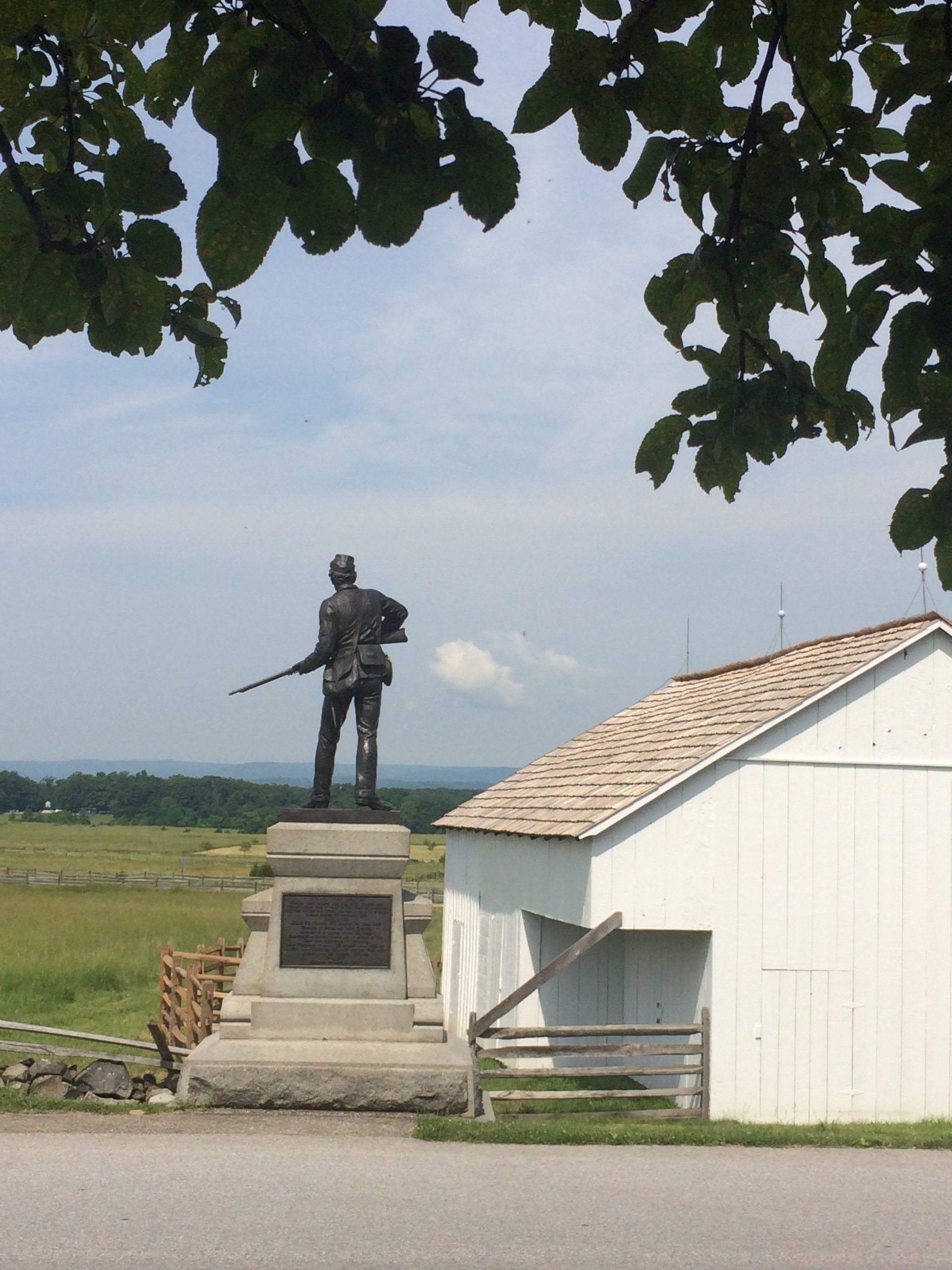Brigadier General Alexander Hays
(US Army War College, Carlisle, PA)
In the midst of Gettysburg’s climactic struggle, on July 3, 1863, it was difficult to see across the field from Cemetery Ridge toward Seminary Ridge, a scant mile to the west. Smoke that belched from hundreds of big guns and thousands of muskets rendered an ominous darkness that obscured the sweltering summer afternoon. As the fight was still undecided, one soldier remembered reaching the ridge, north of the High Water Mark, near the Bryan Farm: “The enemy’s batteries were still playing briskly, and their sharpshooters kept up a lively fire,
”he remembered, “but their infantry, slain, wounded, and routed, were pouring as prisoners into our lines….Then enters Alexander Hays, brigadier general, United States Volunteers, the brave American soldier.” Astride his horse – one of three he would lose that day – the tall Pennsylvanian attached a Confederate flag to his horse’s tail, allowing it to drag in the dirt. The men of his division cheered heartily above the raucous din of battle.1
There were many brave ones on both sides at Gettysburg, and many were unnoticed. Many who should be remembered have been nearly forgotten. One of them was Alexander Hays. Alexander Hays was the youngest of five children born to Samuel and Agnes Hayes, in Franklin, Pennsylvania. He and his four siblings grew up in relative wealth, as his father was a well-respected member of the Pennsylvania Legislature. He also served as a judge in Venango County, near Pittsburgh.2
Hays attended Allegheny College, then entered West Point, as part of the Class of 1844. His classmates included future Civil War commanders Winfield Scott Hancock and Alfred Pleasonton. A cadet who graduated a year ahead of them, Ulysses S. Grant, was one of Alexander’s closest friends. While Hays graduated near the bottom of his class, he excelled in horsemanship and was completely fearless in executing his duties as a soldier. He also, at six feet tall, was someone who readily came to the rescue against any troublemakers – a trait that endeared him to many. His friends called him “Sandy”.3
Hays served with distinction in the Mexican War and was brevetted twice for gallantry. He resigned from the Federal army in 1848, preferring to pursue a civilian life, as he had married Anna McFadden in 1846.
Hays and his bride, one of the belles of western Pennsylvania, were the parents of seven children, four sons and three daughters, all of whom lived to adulthood. Alexander worked for a time as an iron manufacturer, then an assistant engineer of the railroad, and finally as a civil engineer in Pittsburgh. He was working as an engineer when war came in 1861.4
Before the smoke cleared at Fort Sumter, Alexander Hays, who was the captain of the local militia in Pittsburgh, offered his services to the Union. At the start of the war, he served briefly as a captain in the regular army. In the summer of 1861, he helped to raise the 63rd Pennsylvania Infantry, and served as its colonel.5
At the Battle of Seven Pines, part of the Peninsular Campaign in the late spring of 1862, Hays’s dauntless courage caught the eye of David Birney, who recommended him for a promotion to brigadier general, which he received in September that year. Hays was seriously wounded in the leg at Second Manassas, and missed the Battles of South Mountain, Antietam, and Fredericksburg. He was assigned to the Washington defenses, then at the beginning of 1863, he was given a brigade that had shamed themselves at Harpers Ferry. The four regiments, the 39th, 111th, 125th and 126th New York Infantries, derisively nicknamed The Harpers Ferry Cowards, were soon drilled into shape. On the march toward Gettysburg, where General Hays at times rode for twenty-four hours without rest, he still commanded his brigade. A few days before the battle, he was placed in charge of the 3rd Division of the Federal Second Corps – commanded by his friend Hancock. With his symbol the blue trefoil, Hays affectionately called his troops his “bluebirds”.6
At Gettysburg, Hays’s star reached its apogee and the “Harpers Ferry Cowards” redeemed themselves – to their former commander’s satisfaction.
Hays’s former brigade, now led by Colonel George Willard, were called into action on July 2 to halt a disastrous rout caused by Barksdale’s Mississippi Brigade against Charles Graham’s Union brigade in the Peach Orchard. In the storm of lead and bursting shells, Colonel Willard was killed, but Colonel Sherrill, who took command, kept order. In the conflict his men mortally wounded General Barksdale. Watson’s Union Battery, also taken in part by the Mississippi troops, was rescued by the 39th New York – the Garibaldi Guards. The brigade had performed well under fire, and retreated back to Cemetery Ridge in good order, but General Hancock misunderstood what had occurred and placed Sherrill under arrest.7
As the rest of his division deployed at the north end of Cemetery Ridge, Hays was eager to find out what had happened to his old brigade. When he learned of Hancock’s reaction and arrest of the courageous Sherrill – who had been wounded in the face at Harpers Ferry the year before – Hays was indignant. He talked to Hancock and convinced him that he had acted rashly. Sherrill was restored to command in time to continue the fight on July 3, and was mortally wounded during Pickett’s Charge.8
Hays was understandably concerned with certain points of his line. His troops deployed in and around Ziegler’s Grove, where the Union fishhook line curved toward Cemetery Hill. Were the Confederate line, which extended into the town, to continue beyond Hays’s own, the chance of being overrun by flank was entirely possible. Another situation presented itself with the position of the Bliss Farm a few hundred yards to the front of the 3rd Division’s deployment. Confederate sharpshooters crept to the sizable bank barn and, through the slits in the barn’s walls, shot repeatedly at Hays’s men. Hays sent troops to drive the men in butternut away – and they did – but the Southern troops continued to return and harass the blue line.
On the morning of July 3, Hays realized that a frontal assault by the Confederate troops would be aided by the position of the Bliss buildings. At about 11 a.m., according to Hays’s own official report, he ordered troops from the 14th Connecticut and the 12th New Jersey to burn the house and barn.9
The hours differ as to the time the cannonade that preceded Pickett’s Charge began. Hays remembered that “they opened upon our front the most terrific and uninterrupted fire from artillery…eighty pieces bearing upon us.” The Union lines on Cemetery Ridge took cover for about two hours as the Confederate cannon fired. While the Federals took casualties from the onslaught, Lee’s attempt to destroy the majority of troops or render them incapable of defense was unsuccessful – especially fighting against Sandy Hays’s Division. The smoke from the incessant fire engulfed the field and obscured the view. The muddy ground from recent rains imbedded the South's artillery wheels – and changed the trajectory of those myriad guns.10
At about 3 p.m. a light breeze wafted across the field, clearing the smoke. “A heavy column of the enemy moved forward
” from the trees on Seminary Ridge. Three divisions of infantry troops, numbering from 12,000 to 15,000 men “preceded by a strong line of skirmishers” came across the field separating the ridges. Commanders in blue ordered their men to hold their fire, waiting until the Confederates came within range.11
Because General Hays and his men were prepared and well entrenched near the Bryan Farm, the men of Longstreet’s Assault who attacked the Union position there never had a chance to break through. In addition to their intrepid fighting, Hays had the foresight to send the 8th Ohio and two artillery pieces from Woodruff’s Battery into the side of the oncoming Southern troops. They delivered a withering flanking fire that rendered any hope of victory useless. The pages of history give a truthful account of the melée around the Angle and Copse of Trees – where Pickett’s men cut through the Union line – but where General Hays and his division stood, the men of Pettigrew’s and Trimble’s Divisions were mowed down. “In less time than I can recount it,” General Hays wrote, “they were throwing away their arms and appealing most piteously for mercy.” One of his soldiers recalled that the bedraggled troops “threw themselves flat…to escape bullets, and waved hats, handkerchiefs…or whatever they had to signal surrender.”12
When the general rode out among his men in the final moments of the fight, dragging a Confederate flag, it was miraculous that he was not shot down. Or, perhaps there was another reason. Lieutenant David Shields, who at age 21 served on Hays’s staff at Gettysburg, walked the battlefield many years later with a friend who had served as a Confederate officer. The officer remembered seeing General Hays riding along the ridge during the fateful charge, and that he heard one of his superiors say, “Pick that Federal general off.” He was immediately countermanded by his own superior, who said, “No, don’t shoot him. That’s Sandy Hays.”13
In counting the two thousand Confederate dead between the Angle and the Bryan Farm, Hays made a significant notation in his official report: “Found: one female in rebel uniform near angle.”14
A sculptor's rendition of the Bliss Farm, Gettysburg
(Author Photo)
An interesting story on the aftermath of the charge was related by Colonel Clinton MacDougall of the 111th New York, who was wounded during the charge. After having his wound dressed, he walked back toward the line and encountered General Hays in his tent near the Bryan house. As the pair discussed recent events, “Colonel Mac” (as Hays called him) noticed the pile of Confederate banners and counted them. There were twenty-one of various sizes. Within minutes, a staff officer to General Alexander Webb arrived, asking Hays to “ send him some battle flags…which were captured by him [Webb].” General Hays “replied with a great deal of warmth, ‘How in h—l did I get them if he captured them?’” Just then, Hays saw his aide, Lieutenant David Shields, pass by. He called in his stentorian voice, “Oh, Dave! Pick out a half dozen flags and send them to General Webb as a present with my compliments; we have so many here we don’t know what to do with them and Webb needs them.”15
“It is far from my disposition or intention to take one laurel from the brow of any gallant soldier,” Colonel MacDougall opined, “but I am constrained to say that medals of honor and brevets were showered upon others for Gettysburg’s victory that justly belonged to General Hays.”16
Hays did not seek for adulation – which is one reason he was overlooked and another reason why he was so beloved. “It was not my good fortune to be personally acquainted with this General Alexander Hays,” wrote one of his veteran soldiers, “but I wish…to honor him as the bravest of soldiers and love him as the best hearted of men.”17
Because of the fracas caused by General Dan Sickles of the Federal Third Corps on Gettysburg’s second day, many of the men of that corps were killed, wounded, or captured at Gettysburg. The result necessitated a reorganization of the Army of the Potomac. As survivors of the Third Corps were absorbed into the Second and Fifth Corps, David Birney, a division commander from Sickles’s corps was taken into the Second Corps – and took over as a division commander. Hays was relegated back to brigade command.
One of General Hays’s closest friends, Ulysses S. Grant, took over command of all Union armies in early 1864. Realizing that defeating Robert E. Lee was their best option to end the war, Grant rode with Meade’s Army of the Potomac in pursuit of the Army of Northern Virginia and their famous commander. Their first battle of the spring was at a place called The Wilderness, near Fredericksburg – in what was called Grant’s Overland Campaign.
On May 5, 1864, a large battle ensued. As the Union Fifth Corps fought the Confederate Second Corps, additional troops from General A.P. Hill’s Third Corps – ironically the same men against whom Hays’s troops fought at Gettysburg – attacked Hancock’s Second Corps. Hancock, still recovering from his severe wound at Gettysburg, depended on General Hays, his old friend, to hold off the onslaught until he could send reinforcements. Hays, at the head of his brigade, was defending a crossroads in deep woods. During the conflict, a Confederate bullet struck General Hays as he rode to steady his men. He was killed instantly.
The Battle of the Wilderness was inconclusive. General Lee could not break through the Federal lines and Grant, after two days, stopped the fighting and pursued Lee to Spotsylvania. A dark and bloody summer ensued – but the death of General Hays was keenly felt.
“The community will receive with unfeigned sorrow the announcement of the death of Brigadier General Alexander Hays,” wrote a correspondent for The Pittsburgh Gazette. “His…conduct in action was always dauntless and heroic.” The 44-year old patriot was buried in Allegheny Cemetery in Pittsburgh. His wife, like so many war widows, was left to raise their seven children alone, ages 4 through 17.18
Two monuments pay homage to the memory of General Hays. A portrait statue depicts where he stood resolutely against the Confederate assault on the Union center in Ziegler’s Grove on Cemetery Ridge. There is also a memorial, marking the spot where the general fell at The Wilderness, his final battle.
One report glowingly acknowledged that “ for personal gallantry and daring courage, he was one of the most distinguished officers in the United States service.”19
“I reckon him the grandest view of my life,” one New York soldier stated years later. “I bar not Niagara.”20
A view from the Bryan Farm, General Hay's HQ, with the 111th New York
monument facing Pickett's Charge
Sources: 126
th
New York File, Gettysburg National Military Park (hereafter GNMP). Alexander Hays Family Tree, Ancestry.com
. The Baltimore Sun, 09 May, 1864. Bliss Farm File, GNMP. Coddington, Edwin B. The Gettysburg Campaign: A Study in Command
. New York: Charles Scribner’s Sons, 1968. Drake, Francis Samuel. Appleton’s Cyclopedia of American Biography
, vol. 4. New York: private publisher, 1889. Fleming, G.T. Life and Letters of General Alexander Hays
. Pittsburgh, PA: 1919. Copy, GNMP. Hays, General Alexander. Official Report,
vol 27:1, pp. 454-455. Mahood, Wayne. “’Fighting Alex’ Hays at Gettysburg.” Gettysburg Magazine, no. 24, July 2001. Pfanz, Harry W. Gettysburg: The Second Day
. Chapel Hill and London: University of North Carolina Press, 1987. The Pittsburgh Gazette, 09 May, 1864. Rollins, Richard, ed. Pickett’s Charge! Eyewitness Accounts
. Redondo Beach, CA: Rank and File Publications, 1994. Stewart, George R. Pickett’s Charge: A Microhistory of the Final Attack at Gettysburg, July 3, 1863
. Boston: Houghton Mifflin Co., 1959. Warner, Ezra J. Generals in Blue: Lives of the Union Commanders
. Baton Rouge and London: Louisiana State University Press, 1964. Newspapers accessed through newspapers.com.
End Notes:
1. Fleming, p. 282.
2. Hays Family Tree, Ancestry.com. Warner, p. 223. Mahood, p. 106. Hays’s only sister was named Ellen.
3. 126 NY File, GNMP.
4. Drake, p. 146.
5. The Pittsburgh Gazette, May 9, 1864.
6. 126
th
NY File, GNMP. Stewart, p. 66. Pfanz, p. 64. Warner, p. 224.
7. Pfanz, p. 407.
8. 126 NY File, GNMP. Mahood, p. 106.
9. Rollins, p. 281. Bliss Farm File, GNMP.
10. Hays, OR, p. 454.
11. Ibid.
12. Stewart, p 225. Hays OR, p. 455. Coddington, p. 514.
13. Fleming, p. 436. Mahood, p. 105.
14. Hays, OR, p. 455. The mention of the female is a footnote on that page.
15. Rollins, p. 366.
16. Ibid.
17. Ibid, p. 283.
18. Pittsburgh Gazette, 09 May, 1864.
19. The Baltimore Sun, 09 May, 1864.
20. Fleming, p. 282.






